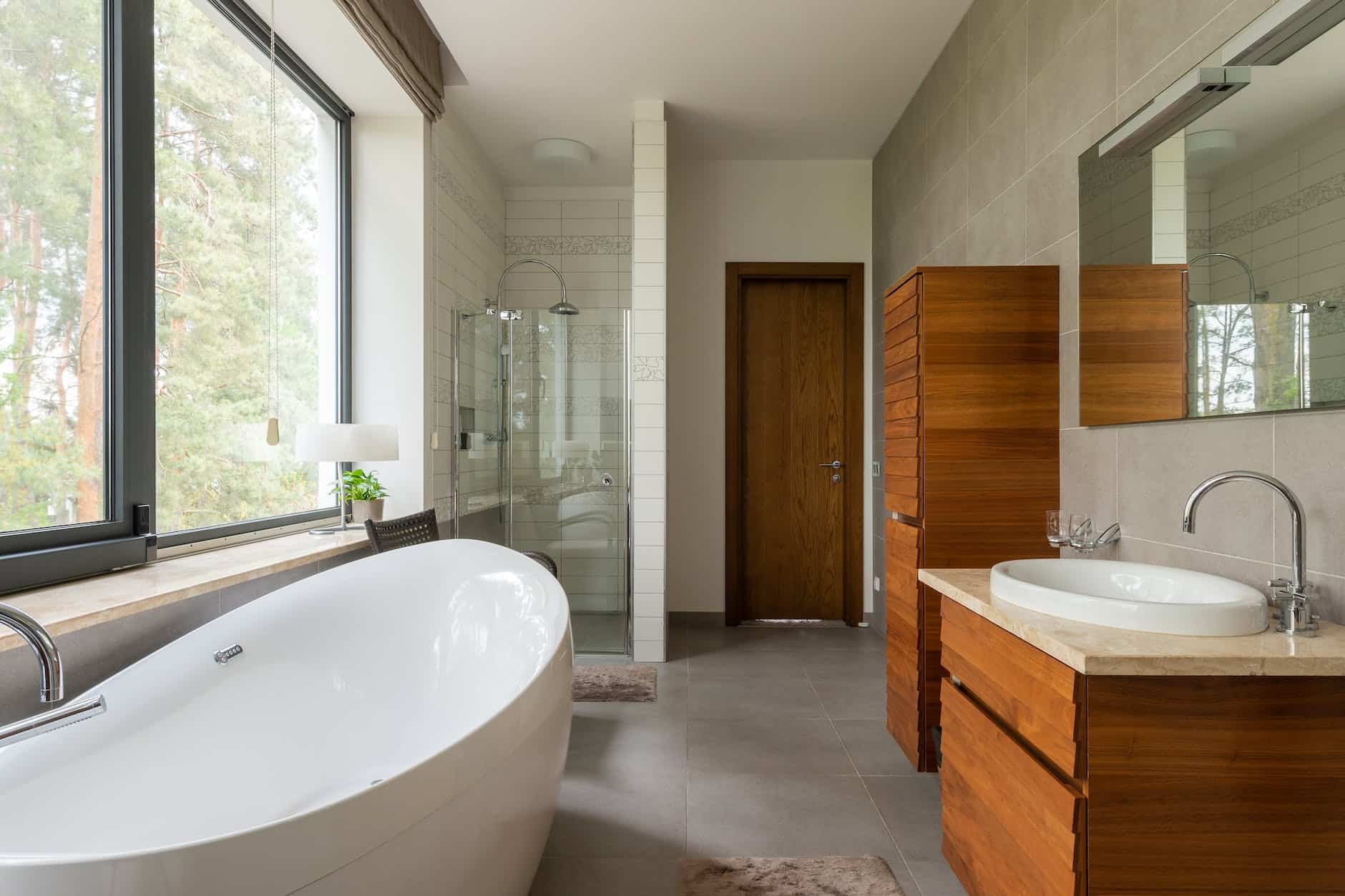The Need for Bathroom Renovations
Bathroom renovations can breathe new life into your home or commercial space, not only enhancing its aesthetic appeal but also improving its functionality and increasing property value. In this section, we explore why bathroom renovations are important and what factors might prompt a renovation project.
Understanding the Importance of Bathroom Renovations
Bathroom renovations are more than just cosmetic upgrades. They play a crucial role in maintaining the quality and value of your property. Renovations can address plumbing issues, improve energy efficiency, and adapt the space to changing needs and trends.
Moreover, a well-renovated bathroom can significantly increase your property’s market value, making it a worthwhile investment. It can also enhance the overall living experience by providing a space that is comfortable, functional, and visually pleasing. For more insights into the value of bathroom renovations, visit our detailed guide.
Factors That Might Prompt a Bathroom Renovation
Several factors might prompt homeowners or property managers to consider a bathroom renovation. These could include:
- Aging Infrastructure: Over time, bathrooms can develop issues like leaking faucets, outdated fixtures, or deteriorating tiles. Such problems can necessitate a renovation to ensure the bathroom remains functional and safe.
- Changing Needs: As a family grows or ages, their bathroom requirements can change. This could mean needing more storage, wanting a larger bathtub, or requiring accessibility features.
- Style Update: Bathrooms can often become outdated in terms of design and style. A renovation can provide an opportunity to modernize the space, aligning it with the latest bathroom renovation trends.
- Increasing Property Value: If planning to sell, a bathroom renovation can make the property more appealing to potential buyers, thus increasing its market value.
- Improving Energy Efficiency: With advancements in technology, renovating a bathroom can also mean upgrading to energy-efficient fixtures, contributing to lower utility bills and a smaller carbon footprint.
Remember, while a bathroom renovation can be a significant undertaking, the benefits often outweigh the effort and cost. However, a successful renovation requires careful planning and execution. Keep reading to discover our step-by-step guide to mastering bathroom renovations.
Planning Your Bathroom Renovation
Embarking on a bathroom renovation requires careful planning and preparation. Critical steps in this phase include setting a budget and creating a timeline for the renovation.
Setting a Budget for Your Renovation
Before starting any renovation project, it is important to establish a realistic budget. The budget should cover all expected expenses, including materials, labor, and any unexpected costs that may arise. To estimate these costs, consider factors like the size of the bathroom, the scope of the renovation, the quality of materials, and labor costs in your area.
Here is a rough budget breakdown:
| Budget Component | Percentage of Total Budget |
|---|---|
| Labor | 40-50% |
| Materials | 30-40% |
| Contingency (unexpected costs) | 10-20% |
For tips on how to plan a budget-friendly renovation, please refer to our article on cost-effective bathroom renovations: tips for budget planning.
Creating a Timeline for Your Renovation
Planning a timeline for your bathroom renovation helps keep the project on track and ensures all tasks are completed in a timely manner. The timeline should account for each step of the renovation process, from initial planning and design to construction and cleanup. Consider possible delays, such as shipping times for materials and unexpected construction challenges.
Here is an example of a typical timeline:
| Timeline (Weeks) | Renovation Stages |
|---|---|
| Week 1 | Initial Planning and Design |
| Week 2-3 | Material and Fixture Selection |
| Week 4-6 | Construction |
| Week 7 | Cleanup and Finishing Touches |
Keep in mind that timelines can vary greatly depending on the scale and complexity of the renovation. For a more extensive guide on planning a timeline, check out our step-by-step guide on bathroom renovations.
By setting a budget and creating a timeline, you can ensure that your bathroom renovation proceeds smoothly and efficiently. These steps lay the foundation for a successful renovation project, leading to a bathroom that is both functional and aesthetically pleasing.
Step-by-Step Guide to Bathroom Renovations
Bathroom renovations can transform your space into a haven of relaxation and functionality. Here’s a step-by-step guide to help you navigate the process:
Step 1: Assessing Your Current Bathroom
Start by evaluating the current state of your bathroom. Identify what works well and what doesn’t. Consider aspects like layout, storage, lighting, and plumbing. This assessment will help you understand what needs to change and what can remain the same. For more specific tips on assessing your bathroom, refer to our article on bathroom renovations.
Step 2: Gathering Inspiration and Ideas
Next, gather ideas and inspiration for your renovated space. Browse through magazines, home improvement websites, or visit local showrooms. Consider current trends and timeless designs that resonate with your personal style. For the latest trends, read our article on modernizing your space: top bathroom renovation trends of 2024.
Step 3: Creating a Design Plan
With your ideas in place, create a design plan. This should include the layout, color scheme, and the type of fixtures and fittings you want. Consider using a professional designer to help with this step, especially if you’re planning a major renovation. For more help with this step, check out our article on cost-effective bathroom renovations: tips for budget planning.
Step 4: Selecting Materials and Fixtures
Choose materials and fixtures that align with your design plan and budget. Consider durability, maintenance, and aesthetics when making your selections. For more advice on choosing materials, read our article on choosing the right materials for your bathroom renovation.
Step 5: Hiring Professionals vs. DIY
Decide whether you’ll be hiring professionals or undertaking a DIY renovation. Both options have their pros and cons. While professionals can ensure a high-quality finish and adhere to building codes, a DIY project can be cost-effective if you have the necessary skills. To decide which route to take, read our article mastering DIY: essential skills for bathroom renovation projects.
Step 6: Preparing for Construction
Before construction begins, make sure you prepare your home. This might involve setting up a temporary bathroom, protecting nearby rooms from dust, and informing your neighbors about the upcoming construction noise.
Step 7: Monitoring the Renovation Process
Once the renovation starts, keep a close eye on the progress. Regularly communicate with your contractors or periodically check on your DIY work to ensure everything is going as per the plan.
Step 8: Finishing Touches and Clean Up
After the bulk of the renovation is complete, add the finishing touches. This could include painting, installing hardware, or decorating with accessories. Once everything is in place, do a thorough clean-up of your newly renovated bathroom.
Through careful planning, gathering inspiration, creating a design plan, selecting the right materials, and deciding on DIY or professional help, you can navigate your bathroom renovation smoothly. Always keep an eye on the process and add those final touches to make your bathroom truly yours. For more tips and tricks on bathroom renovations, explore our comprehensive collection of articles.
Tips and Tricks for Successful Bathroom Renovations
A successful bathroom renovation requires more than just a solid plan and high-quality materials. It also involves foreseeing potential problems, managing finances wisely, and making design choices that balance functionality with aesthetics.
Planning Ahead for Unexpected Issues
In any renovation, unexpected issues can arise, particularly in older properties. These might include hidden water damage, outdated plumbing, or structural challenges that aren’t apparent until the renovation begins. To mitigate these surprises, a thorough pre-renovation inspection can help identify potential problems. Additionally, having a flexible renovation timeline can accommodate unexpected delays. Learn about common pitfalls in our article on expert advice: common bathroom renovation mistakes to avoid.
Keeping a Contingency Budget
When budgeting for a bathroom renovation, it’s crucial to set aside an additional 10-20% of the total cost as a contingency fund. This extra money can cover unforeseen expenses, such as structural repairs, additional labor costs, or price increases for materials. You can find more tips on budget planning in our article on cost-effective bathroom renovations.
Balancing Functionality and Aesthetics
A well-designed bathroom balances functionality with aesthetics. While it can be tempting to focus on selecting stylish fixtures or trendy tiles, it’s just as important to ensure the layout is practical. Consider factors like storage, lighting, and ease of movement. For more design tips that maximize small spaces, refer to our article on maximizing small spaces: innovative bathroom renovation ideas.
Ensuring Proper Ventilation and Lighting
A well-ventilated and well-lit bathroom can prevent mold growth, protect fixtures, and enhance the overall ambiance. When planning your renovation, ensure there’s adequate ventilation, either through an exhaust fan or a window. Similarly, consider a variety of lighting options, such as ambient lighting for overall illumination and task lighting for specific activities like applying makeup.
Choosing Durable and Easy-to-Clean Materials
The materials you choose for your bathroom should withstand moisture, frequent use, and cleaning products. Porcelain and ceramic tiles are popular choices due to their durability and ease of maintenance. Similarly, quartz and granite are resilient choices for countertops. For more guidance on selecting materials, refer to our article on choosing the right materials for your bathroom renovation.
Remember, a successful bathroom renovation is never rushed. With careful planning, wise budgeting, and thoughtful design choices, you can transform your bathroom into a space that’s functional, stylish, and a pleasure to use.
Maintaining Your Renovated Bathroom
After completing your bathroom renovations, the subsequent task is to maintain the new space. This involves regular cleaning and maintenance, periodic checks for plumbing and electrical issues, and updating decor as needed.
Regular Cleaning and Maintenance
Regular cleaning and maintenance are paramount to keeping your renovated bathroom in pristine condition. This includes routine tasks like wiping down surfaces, cleaning the shower or tub, and keeping the fixtures polished. Not only does this keep your bathroom looking fresh, but it also helps extend the lifespan of your materials and fixtures.
For cleaning, avoid using harsh chemicals that may damage your new surfaces. Instead, opt for mild cleaners or even natural alternatives like vinegar and baking soda. Regular maintenance also includes checking the grout and sealant around your tub or shower and replacing it when necessary.
Periodic Checks for Plumbing and Electrical Issues
In addition to regular cleaning, it’s important to conduct periodic checks for plumbing and electrical issues. This includes looking for leaks, monitoring for slow drains, and ensuring all electrical fixtures are functioning properly. If you encounter any issues, it’s best to address them immediately to prevent further damage or costly repairs down the line.
Remember, while some minor plumbing or electrical issues can be handled DIY, it’s always best to call in a professional for major concerns. This ensures that the job is done safely and correctly, preserving the integrity of your renovation.
Updating Decor as Needed
Lastly, to maintain the aesthetic appeal of your renovated bathroom, consider updating the decor as needed. This doesn’t necessarily mean major changes. Even small updates like swapping out towels or changing the shower curtain can have a significant impact on the overall look and feel of the space.
When updating your decor, remember to keep in mind the overall style of your bathroom. Whether it’s modern, rustic, or traditional, ensure your decor complements your design theme. This helps maintain a cohesive look and enhances the overall aesthetic of your renovated bathroom.
Keeping your newly renovated bathroom in top shape requires consistency and attention to detail. By adhering to a regular cleaning schedule, conducting periodic checks for potential issues, and updating decor as needed, you can enjoy your renovated space for years to come. For more tips and advice on bathroom renovations, check out our comprehensive step-by-step guide for homeowners.




